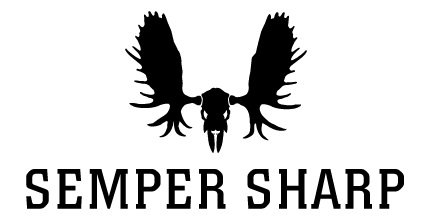What goes into our knives
Steel- We are very picky about the blade steel we use to make knives. We have tested many types of steel over the past couple of years, and how now settled on our favorites for a few different reasons.
When we choose steel for a knife we look for different characteristics of steels that would work each knife. We focus on how the knife will be used when considering certain steel for that application. The main areas we are looking at are:
· Hardness- Hardness is the steel’s ability to resist deforming when subjected to pressure, stress, and applied forces. Hardness relates to the strength and edge retention of a blade.
· Edge Retention- Edge retention is the strength of the blade. The stronger the blade, the higher ability to retain a razor-sharp edge. Edge retention is on the top of this list for a reason. Living in Alaska puts us in situations where we are processing very large game. I do not want to stop every 30 minutes to sharpen a knife while processing a 1500 pound bull moose. The same stands for our fillet knives. Pulling 50 salmon from a day with dip-net in Alaska is common. It is also common to see folks bring a 5-gallon bucket of cheap fillet knives fishing. When one knife gets dull, they drop the knife and grab a different one from the bucket. Our goal was 50 salmon without sharpening in between. We have had folks get into the 100’s without a touchup on the blade!
· Toughness- Blade toughness is another property we highly consider when paring blade steel to a particular knife. Toughness is a measure and scale of how well the steel responds to striking. As the hardness of steel increases the toughness decreases. The challenge for knife makers to optimizing both of these areas for each specific use of a certain knife. For example, Chef knives are meant to cut vegetables, fruit, and other softer foods. The edges of these knives are ground very thin and are also very hard. These characteristics work amazing in dicing veggies, but if you were to use this knife to cut through boney meat you could chip the edge of the knife. On the other end of the spectrum, you have a boning knife. A boning knife’s edge is ground to a steeper angle and tempered to a lesser hardness. This will allow the knife to go up against bone and not chip. The characteristics of a boning knife will not make it the best choice in cutting veggies but is perfect for splitting ribs and de-boning wild game.
· Corrosion Resistance- Corrosion resistance is the steel’s ability to resist stains. In the past, there used to be a trade-off between edge retention and the steel’s ability to fight rust and other stains. Today with modern technology premium steels are able to hold an edge for an incredibly long time and still resist stains. Knives still need to be cared for, but there should be no hesitation in taking your fillet knife out in saltwater conditions. No knife will do well if soaked in saltwater, high humidity environments, or high heat conditions for extended periods of time, but with proper care, you will never see rust on your blade.


